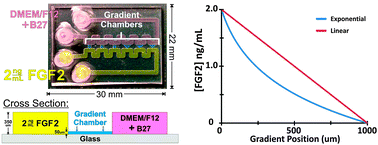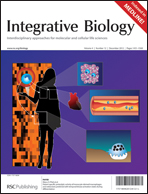In vitro localization of human neural stem cell neurogenesis by engineered FGF-2 gradients†
Abstract
The development of effective stem cell-based therapies for treating brain disorders is keenly dependent upon an understanding of how to generate specific neural cell types and organize them into functional, higher-order tissues analogous to those of the cerebral cortex. Studies of cortical development have revealed that the proper formation of the human cerebral cortex results from specific intercellular interactions and soluble signaling between the highly-proliferative region occupied by dividing neural stem cells and an adjacent region of active neurogenesis and neural migration. However, the factors responsible for establishing this key asymmetrical proliferative-neurogenic architecture are not entirely known. Fibroblast growth factor 2 (FGF-2) is observed in a ventricular-pial gradient during in vivo development and has been previously shown to have effects on both human neural stem cell (hNSC) proliferation and neurogenesis. Here we have adapted a microfluidic approach for creating stable concentration gradients in 3D hydrogels to explore whether FGF-2 gradients can establish defined regions of proliferation and neurogenesis in hNSC cultures. Exponential but not linear FGF-2 gradients between 0–2 ng mL−1 were able to preferentially boost the percentage of TuJ1+ neurons in the low concentration regions of the gradient and at levels significantly higher than in non-gradient controls. However, no gradient-dependent localization was observed for dividing hNSCs or hNSC-derived intermediate progenitors. These data suggest that exponential FGF2 gradients are useful for generating asymmetric neuron cultures, but require contributions from other factors to recapitulate the highly-proliferative ventricular zone niche. The relevance of the findings of this study to in vivo cortical development must be more cautiously stated given the artifactual nature of hNSCs and the inability of any in vitro system to fully recapitulate the chemical complexity of the developing cortex. However, it is quite possible that exponential FGF2 gradients are employed in vivo to establish or maintain an asymmetric distribution of neurons in the ventricular-pial axis of the developing cerebral cortex.


 Please wait while we load your content...
Please wait while we load your content...